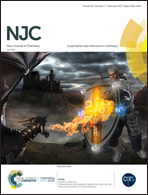Syntheses and structural aspects of six-membered palladacyclic complexes derived from N,N′,N′′-triarylguanidines with N- or S-thiocyanate ligands†
Abstract
Six-membered palladacyclic complexes derived from N,N′,N′′-triarylguanidines, [Pd{κ2(C,N)}(μ-NCS)]2 (1–4), trans-[Pd{κ2(C,N)}(NCS)L] (L = nitrogen based planar Lewis bases, 5–7) and cis-[Pd{κ2(C,N)}(X)L] (L = phosphorus based conical Lewis bases, X = NCS or SCN) that contained N bound thiocyanate (8 and 10–16) and S bound thiocyanate (9) were isolated in good yields. trans-[Pd(κ1C-guanidine)(NCS)(PMe3)2] (17 and 18) were isolated in good yields in order to understand the factors that decide the thiocyanate coordination modes in 5–16. The new complexes were characterized by analytical techniques, IR and multinuclear NMR (1H, 31P and 13C) spectroscopy and further the molecular structures of thirteen complexes were determined by single crystal X-ray diffraction. The Pd(II) atom in 5·CH2Cl2 and 6·PhMe revealed a trans configuration while that in the remaining structurally characterized monomeric palladacycles revealed a cis configuration. Palladacycles 8·2/3PhMe and 9·MeOH represent the first pair of structurally characterized linkage isomers of organopalladium complexes to be reported. The influence of solvents on thiocyanate coordination modes in 8·2/3PhMe and 9·MeOH is discussed. Theoretical studies were carried out on the 8 and 9 pair and on their model complexes, 8′ and 9′, and in both cases an N bound isomer was found to be more stable than their S bound counterpart by 6.14 and 4.64 kcal mol−1, respectively. In the case of methanol bridged dimers of 8′ and 9′, namely 8′′ and 9′′, the N bound isomer (8′′) is more stable by 8.11 kcal mol−1 suggesting the possible role of lattice methanol and its intermolecular interactions with 9 in the crystal lattice for the observance of a S bound thiocyanate coordination mode. The Wiberg bond index calculations were carried out on 8′ and 9′ which suggested the dominance of Pd ← N![[double bond, length as m-dash]](https://www.rsc.org/images/entities/char_e001.gif) C
C![[double bond, length as m-dash]](https://www.rsc.org/images/entities/char_e001.gif) S (F) and Pd ← S–C
S (F) and Pd ← S–C![[triple bond, length as m-dash]](https://www.rsc.org/images/entities/char_e002.gif) N (H) resonance forms, respectively.
N (H) resonance forms, respectively.



 Please wait while we load your content...
Please wait while we load your content...